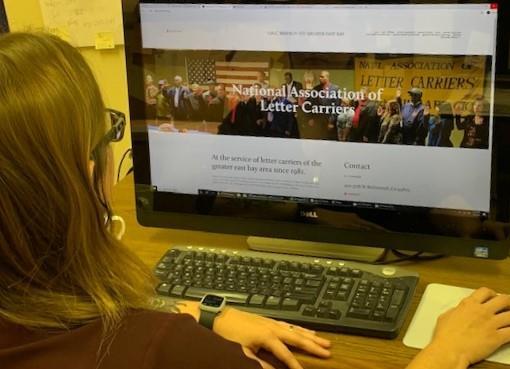
28 minute read
Branch 1111 News
Volume 40 Number 449 January 2020
BRANCH 1111 2.0.2.0
Advertisement
www.Branch1111.org
FTO Julie McCormick working on the Branch 1111 website. Our monthly Branch newspaper is available each month in full color on both our website and on our Facebook page, as well as other resources and information for our members www.facebook.com/nalcbranch1111 1
NALC HEALTH BENEFIT PLAN SERVICE LINES
General Claims Inquiries 1-888- 636-NALC Hospital Precertification (Required) 1-800-622-6252 Prerecorded Benefits Information 1-888-636-NALC Prescription Customer Service Line 1-800-933-NALC

BRANCH PAPER DEADLINE
The deadline for copy for Branch 1111 News is the 3rd of each month. News stories, articles, letters, drawings, or cartoons, as well as photographs -- either recent or historical -- should be submitted to the Branch office. Short notices of personal or shop floor interest are especially welcome. The Editor retains the right to edit, delete, or reject articles and artwork for the good of the Branch.
BRANCH 1111 OFFICERS
Edward P. Fletcher, President Jose Ochoa, Executive Vice President Narciso Paderanga, First Vice President Francisco Cabrera , Second Vice President Julie McCormick, Third Vice President Terrence Super, Fourth Vice President John Ferreira, Secretary-Treasurer Mary Phelps, Asst. Sec-Treasurer Keith Massey, Sgt-at-Arms Jacob Morgan, Insurance Officer Jose Corral, Trustee Jerry DePoe, Trustee Ron Jones, Trustee
EXECUTIVE COUNCIL MEMBERS Christina Aviles, Elizabeth Corriea, Rickie Cox, Marisela Fletcher, Ray Garcia, Joshua Pearl, Frances Rodriguez-Swint
BRANCH 1111 OFFICE HOURS Monday-Friday: 8 am to 5 pm 402 –37th Street Richmond, Ca. 94805- 2134 510-237-5111, Fax 510-237-5181
FACEBOOK: www.facebook.com/nalcbranch1111
WEBSITE: www.Branch1111.org
Meetings are held every fourth Tuesday of the month
Greater East Bay
Branch 1111 News
Branch 1111 News is the official monthly publication of the National Association of Letter Carriers (NALC), Greater East Bay Branch 1111. Circulation 3,000
Offices Served: Alameda, Alamo, Antioch, Benicia, Berkeley, Brentwood, Clayton, Concord, Crockett, Danville, El Cerrito, Fairfield, Fremont, Lafayette, Livermore, Martinez, Moraga, Oakland, Orinda, Pinole, Pittsburg, Pleasanton, Richmond, Rodeo, San Lorenzo, San Ramon, Suisun City, Union City, Vallejo, Walnut Creek
BRANCH 1111 NEWS STAFF
Editor - Joshua Pearl: joshpbranch1111@gmail.com Assistant Editor –John Jekabson: jjbranch1111@gmail.com
Contributors -- Ed Fletcher, Jose Ochoa, John Ferreira, Narciso Paderanga, Julie McCormick, Liz Corriea, Ron Jones, Jerry DePoe, Francisco Cabrera, Julie McCormick, Mary Phelps, Terrence Super, Keith Massey, Jacob Morgan
Views expressed in Branch 1111 News do not necessarily reflect the views of the Editor, Branch Officers, or members of National Association of Letter Carriers, Branch 1111
Happy New Year!
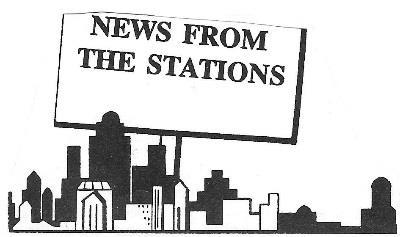
TSP Performance All but one of the portfolios in the federal government’s 401(k)-style retirement savings program ended the year on a high note, wrapping up a 2019 in which all funds grew in value. Leading the way for the Thrift Savings Plan last month was the international (I) fund, which gained 3.24% in December. In 2019, the I Fund increased 22.47%.
The common stocks of the C Fund increased 3.01% last month, bringing its 2019 total gains to 31.45%. And the smalland mid-size businesses of the S Fund grew 2.15% in December, for a total increase of 27.97% in 2019.
The G Fund, which is made up of government securities, increased 0.16% last month, bringing its 2019 total to 2.24%. The fixed income (F) fund was the only TSP portfolio to end December in the red, falling 0.08%, but its performance last year remained positive at 8.68%.
All of the TSP’s lifecycle (L) funds, which shift toward more stable investments as participants get closer to retirement, ended the year on a positive note. The L Income Fund, which is designed for people who already have begun taking withdrawals, increased 0.74%; L 2020, 0.86%; L 2030, 1.83%; L 2040, 2.15%; and L 2050, 2.43%.
HAPPY TRAILS TO YOU!
The following carriers retired recently: Juan Macapinlac of Alamo, Diane Miguel of Concord, Gaida Partido of Danville, Julito Agbuya of Fremont, Edwin Valenzuela of Livermore, Francisco Villena Jr of Oakland, and Anna Robards of Walnut Creek. We wish many years of leisure to all!
Based on the release of the November 2019 CPI-W (1982- 84=100)’ the 2020 FECA COLA projection is 2.4%. The November 2019 CPI-W of 250.644 was 2.4% above the December 2018 base inde4x (244.786). The 2020 FECA COLA calculation will be finalized when the December 2019 CPI-W is published during the month of January 2020
Next Branch Meeting: January 28, 7:00
Important 2020 Dates to Remember:
Steward’s Brunch March 22 State Convention April 30-May 2 Food Drive May 9 Branch Picnic June 28 National Convention August 17-21 Retiree’s Night August 25
Last day on the job for Alamo’s Juan Macapinlac
(photo by Jonathan Quintos)



Remembering and honorin Dr. Martin Luther King January 20
PRESIDENT’S VIEW Unilateral Route Inspections
By Edward P. Fletcher, President
4 The Handbook, M-39, Management of Delivery Services, Chapter , clearly outlines the proper procedures for Mail Counts and Route Inspections on Letter Carrier assignments. As per the M-39 Section 211.2, the USPS must select the period for route count and inspections, as far in advance as possible, and notify the local union of the schedule. Although management routinely notifies us when they are conducting unilateral route inspections in our offices, they do not notify us of how they plan on cheating the system. Instated, we usually receive numerous complaints about how the inspections were conducted, the mail volume mysteriously being too light, the staffing and/or distribution issues magically disappear. As well as complaints about the conduct of the route examiners who are only supposed to be observing and taking notes. Understanding the Route & Inspection Process
First of all, and with no “Joint Route Inspection Agreements” in sight, management does have the right to conduct mail counts and route inspections, except in the summer months and the month of December. Of course, that right does not supplant their obligation to conduct fair and proper route counts, inspections and adjustments in accordance with the National Agreement. There should be no changes in normal mail distribution, clerk schedules or cut off times during the week of inspection. No accumulation of curtailed mail on the day proceeding the count or the last day of count. The regular carrier should count and record the mail every day, except on the day of inspection.
Upon request, the carrier has the right to verify the mail count(s) performed by management. All routes must receive full credit for any/all auxiliary assistance provided. Carrier should request and keep copies of all PS Forms 3996’s, including any sections for their routes. Examiners should not be giving you instructions on how to do your route, nor set a pace for the carrier, cannot forbid any comfort stops, should not open doors and/or gates or discuss the route inspection with the carrier. In short, the carrier should deliver the route as they normally do through the year.
It is important to know that a carrier should get proper credit for all line item work functions performed, and not just casing and/or delivering mail. Management is also required to conduct carrier consultations for the evaluation and adjustment portions of the process, and record the carrier’s comments, accordingly. What Should We Do During the Inspections?
First of all, eight hours of work for eight hours of pay. That’s what we want. No more, no less. All thought the M-39 Section 242.112 states that, “the proper adjustment of carrier routes means an equitable and feasible division of the work among all carrier routes assigned to an office,” most carriers will tell you that wasn’t even close to being done. Carriers should take detailed notes of any and all changes during the week of inspection that may have affected them receiving a fair and accurate route inspection and/or adjustment and share them with the union.
If you are placed on Line 22 (waiting time- no work performed) by management, whether it is in the office and/or on the street, note the beginning and ending times, as well as the reason. Any time changes to a carriers’ base street time allegedly due to identified improper practices or operational changes, must be documented by appropriate comments on the reverse of the PS Form 1840 or attachments thereto and must be discussed at the time of the consultation concerning the route evaluation. If the carrier notes absence of the documentation in writing on the PS Form 1840, the carrier should initial and date the PS Form 1840 or attachments thereto. If management does not supply the documentation within 1 week, the time adjustment shall be disallowed (M-39 Section 242.345). What Can We Do After the Inspections? Many carriers mistakenly think that once the week of inspection is over and their routes were not properly evaluated and/or adjusted, that there is nothing that we can do. That is not the case. Even if you route was improperly adjusted or overburdened, management is required to review their adjustments. So, it is crucial that every carrier after the implementation of the route adjustments do eight hours work for eight hours pay and not run, skip and/or shorten their lunch and/or break times. In fact, this can be said for the rest of the year as well since management is also required to pull seven random weeks for a timecard analysis and the week following the week of inspection for your route (Form 1840-B). When you are interviewed by the union, please provide detailed notes and information for a possible grievance.
Even if your route was properly adjusted or slightly over eight hours and the workload subsequently grew to eight and a half hours a day, three days a week over a six week period, you would qualify and could file for Special Route Inspection (SRI) in writing. If you need the form for a SRI, please ask your local shop steward. In any case, we must collectively do everything that we can do, to make things right and hold them accountable to our contract
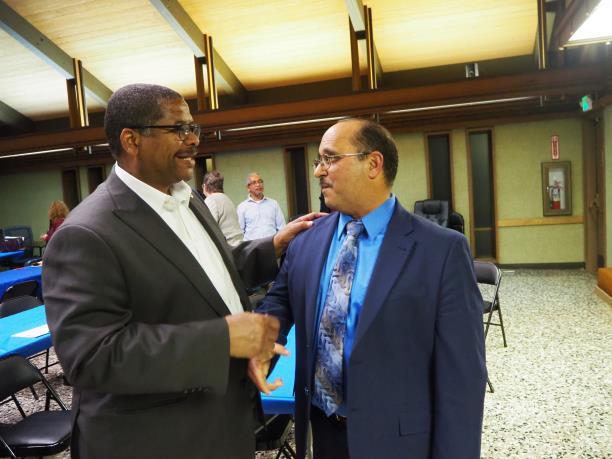
New Year, Same Management Dinosaurs By Jose Ochoa, Executive Vice President
Well, first let me recognize what an impressive, well done job you all did during our busy Holiday Season; not even UPS, Fed EX and Amazon put together delivered as much as all of you did. On the contrary, they came to the USPS for help and we delivered! Your Stewards and Full Time Officers also had a very demanding 2019. Your Branch filed a grand total of five thousand eight hundred and eighty two grievances (5,882). As usual, the same offices notorious for not being able to keep new carriers, try to make up for their ineptitude by working the remaining carriers extra-long hours and canceling days off.
For example, at the Berkeley DDU office, things got so bad that carriers had to get medical restrictions, some with either an 8, 10 or 12 hour a day limitation. Still, the 12 hour medical limitation wasn’t good enough for the DDU. Managers and some carriers went out on stress because they couldn’t deal with the BS. Right away the dinosaurs in the District want to fix the problem by ordering discipline, no matter how bogus. This discipline is nothing more than an attempt by these phonies to justify their high salaries and existence. Carriers are not the problem or solution to mismanagement. The issue is those managers that keep on causing chaos in every single position-office where they are placed. It is obvious the stooges at the District Area see no evil. To them it is all about working and making the numbers look good.
Well, this Branch is ready to take on those managers/supervisors and 204b’s. We have files of the history about your prior abusiveness and bullying. We are waiting to “hold you accountable.” You know who you are and we know who you’ve been. If carriers don’t have a proven pattern of calling in sick (like some of your supervisors) when you call in sick for less than 3 days and you get the automated request for medical documentation, it means you have been placed on restricted sick leave in direct violation of the National Agreement. If this happens, request to see your shop steward right away. Please sisters and brothers, begin the New Year with a stronger will for solidarity and unionism. Together we can affect a change. Was this karma? Recently a supervisor was placed on the very same route of the carrier he had harassed and followed almost every day, demanding the carrier finish in 8 hours. Causing the carrier to finally go out on stress. Guess what? The supervisor returned late to the office with undelivered mail, clocked out, and has been missing in action ever since. Maybe the route wasn’t eight hours after all….hahaha.
New Decade, Same Problems. By Narciso Paderanga, IV, First Vice President
It’s a new decade but let’s see what the USPS will do differently. Will it ever fix the staffing issue? What are its plans to fix the staffing issue? Every year it is the same struggle. Not enough bodies to cover the routes which leads to ridiculously long daily hours for all carriers. It cannot hire enough new employees. It cannot keep the new employees on board.
Just recently, several new employees, both career and non-career, have decided to resign from the Post Office. The Service needs to figure out the root causes and fast. Before we know it, this year’s elections and the busiest time of the year will be here. Now is the time! At the previous labor –management meeting(s) at the district level, Bay Valley District leaders have requested assistance from the local Branches in the hiring process or recruitments. Personally, I have submitted several names of applicants to them, but as of the date I am writing this, I have not seen it come to fruition. Carriers must understand the NALC does not conduct the hiring process, it is management. It is also management that can control the environment in which it places new employees to ensure they stay on board during probation.
Normally, the Branch is not informed of the new employees’ resignations until days or weeks later. The main reasons are typically the same; -- the job is not for them or too many days of long hours or both. Nothing can be done if they feel the job is not for them but certainly something has to be done with the latter.
Why does management keep a new employee until almost the last day of the probationary period then let them go prior to passing? Why not figure out how to help that new carrier improve by providing more training. Historically, when an accident (minor or major) occurred, local management have tricked new employees into resignations instead of being fired, by promising them a better opportunity to be rehired by the Postal Service in the future. I have yet to be informed of those carriers who were actually rehired. I urge you to assist new employees in becoming successful in what they do, because in the long run, it can only benefit you and your fellow carriers in your office. Find out how they are doing and if there are any issues that may result in discontinuing their careers with the USPS and let the Branch know immediately. Let’s try to fix it together.
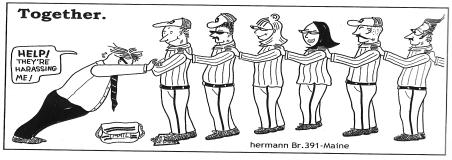
“Go Talk to Jose…” By Francisco Cabrera, Second Vice President
In keeping with the tradition of honoring long time Union advocates for Branch 1111, I now must write about one of our long time Union Officers: Jose M. Ochoa.
You see I have known him for almost 17 years. I remember being a carrier in Concord where he was our Chief Steward. I can picture him walking out of the Union office in uniform, recently tanned fromone of his vacations, smile on his face, with that defiant walk….
But one moment in time that I will always remember, is him standing in section 4 and 5 in the Concord Post Office, standing behind the case of another carrier that was being observed. He was observing the managers observing this carrier. He had hisarms crossed, standing his ground. This perhaps was a meaningless moment for him,or anybody else for that matter, as nobody else seemed to notice. The carrier was casing erratically, in a nervous panic, from being observed by twomanagers. And Jose Ochoa was just standing there with a stoic look on his face. I remember…I had only been employed by the USPS maybe 6 months or so. I approached him between picking up flats or letters. I don’t remember which (maybe I was just wandering around the office, I did that a lot before I became a stewardsometimes I still do). I asked him what’s going on, as the managers standing there observing the carrier acted like Jose didn’t even exist and wasn’t standing there.
Jose in his signature gesturing style just gave me a backhand wave and a wink. I knew I shouldn’t insist, so I just nodded and kept going about my business. To me this moment represented a pillar of hope. Nobody had to submit to the idea that management controls the capital, the work rules, the hiring and firing decision. In other words, that they “hold all the cards”. That it’s their way or the highway.
Jose Ochoa is the reason I first wanted to become a shop steward.
I can still remember the time I was let go on the last day of my probationary period. I approached the chief steward for the Mail-Handlers Union in Concord at that time and I informed him that I had received a letter of separation a few minutes ago. He said go talk to Jose. I did and Jose helped me get my notice of Separation rescinded.
In the last few years since I’ve been a full time officer for NALC Branch 1111, I have spent a lot of time with Jose. I can remember him telling me how him being a union officer is what he considered himself to be, above all else. I will always remember how Jose Ochoa inspired me, how he represented that beacon of light in a darkened office. I leave you with some words of wisdom he shared with me once: “You have a pretty good life, don’t ruin it.” We letter carriers have a pretty good life thanks to our unionized careers at the USPS. So I tell you the same: “Don’t ruin it.”
NALC BRANCH 1111 SCHOLARSHIP APPLICATION
Applications are being accepted for the Branch 1111 Katherine Ellis Memorial Scholarship. Applicants must submit the form provided below no later than February 28, 2020 Eligibility requirements:
1) The applicant must be a member of the graduating class of 2019-2020 2) The applicant must be so or daughter or legally adopted child/ stepchild of a member in good standing with Branch 1111. Any questions about the scholarship should be referred to John Ferreira of the Scholarship Committee at: 510-237-5111 (Please print clearly) Date______________ Please send instructions as to how I can compete for the Scholarship Award. I will be a senior in the year 2019-2020 I am the child of (active) (retired) or (deceased) member ___________________________________ (name) My Name is ____________________________________________ My Home Address is ________________________________________________ _____________________ My Social Security Number is ______-____-______ Signature of NALC Parent______________________ Office/Station of Parent Member _______________________ Branch Official _______________________ NALC Parent’s Social Security Number______-____- ______ Title______________ Date ______________
Being Patient with the Dispute Resolution Process/Grievance Procedure
By Terrence Lee Super, Fourth Vice President
When a carrier’s contract is violated, the carrier knows it and wants us to file a grievance immediately! That carrier seems to want immediate justice, which is understandable. But, what our dear members need to realize is that the Dispute Resolution Process or Grievance Procedure doesn’t work that way. Even if the carrier is totally in the right and we have an ironclad case, that carrier will not receive immediate compensation. For example, let’s say a CCA has not received their Uniform Allowance. Contractually, management has violated that part of the Contract which states that after a CCA has gone through their 90 workday or 120 calendar day probation, they get a Uniform Allowance. Well, by management not providing the CCA with their Uniform Allowance within that time period, it is an Article 26 Section 3 violation. Of course, management doesn’t care, so we end up having to file a grievance just to get a basic contractual right to have a Uniform Allowance.
So, in this example there is a CLEAR violation that we can prove yet the CCA that’s owed the Allowance still must wait. Let me explain: The CCA lets us know that they didn’t get their Uniform Allowance. First, we have to file that grievance at the Informal Step A within the 14-day time limit. This is usually with the Supervisor. Even if we prove our case at that first level, the Supervisor we’re meeting with doesn’t have to agree to resolve it. This is another grievance within itself because both parties should try to resolve issues at the lowest level, which is Informal Step A. If management chooses not to resolve the case at Informal Step A, we now have to appeal that case to the next level, which is Formal Step A, within 7 days. Once the Postmaster receives the appeal, he/she has 7 days to schedule the Formal Step A meeting. At this level, the Postmaster or designee for that office and the Union discuss all evidence gathered in the case file and try to resolve it, which again the Postmaster does not have to agree. But still that same rule applies that both parties should, in good faith try to resolve it at the lowest level.
In the example so far, counting the 14 days in which we must initially file the grievance, then another 7 days to appeal, after which the Postmaster has 7 days to schedule a Formal Step A meeting. Thus far, it has been a possible 28 days in the grievance procedure and you still don’t have your Uniform Allowance. Irritating, isn’t it? But wait, there’s more! Let’s say at the Formal Step A level, the Postmaster or designee doesn’t want to resolve it? At this point, we then have to appeal again to the next level, The Dispute Resolution Team, where we have an unbiased union representative and an unbiased management representative go over all the evidence in the case file and then make a decision based on only that facts and proof therein. They must make a decision within 14 days of receiving the appeal, which is not realistic because of the amount of grievances we file and are sent to the DRT, who are at times backed up and cases may take longer for them to get to and make decisions on.
What we at Branch 1111 are saying is that our grievance procedure may not be perfect, but as officers we believe in it and it may take a little time to get a decision on your grievance, but it will be well worth it when it comes. All we ask is that you be patient. Management knows that it takes time to get a decision back that has been sent to the DRT, and sometimes they refuse to resolve a grievance on purpose. Just to make you wait, which is despicable, but we will always fight for you and continue to support you no matter what. Just……please……. be……. patient.
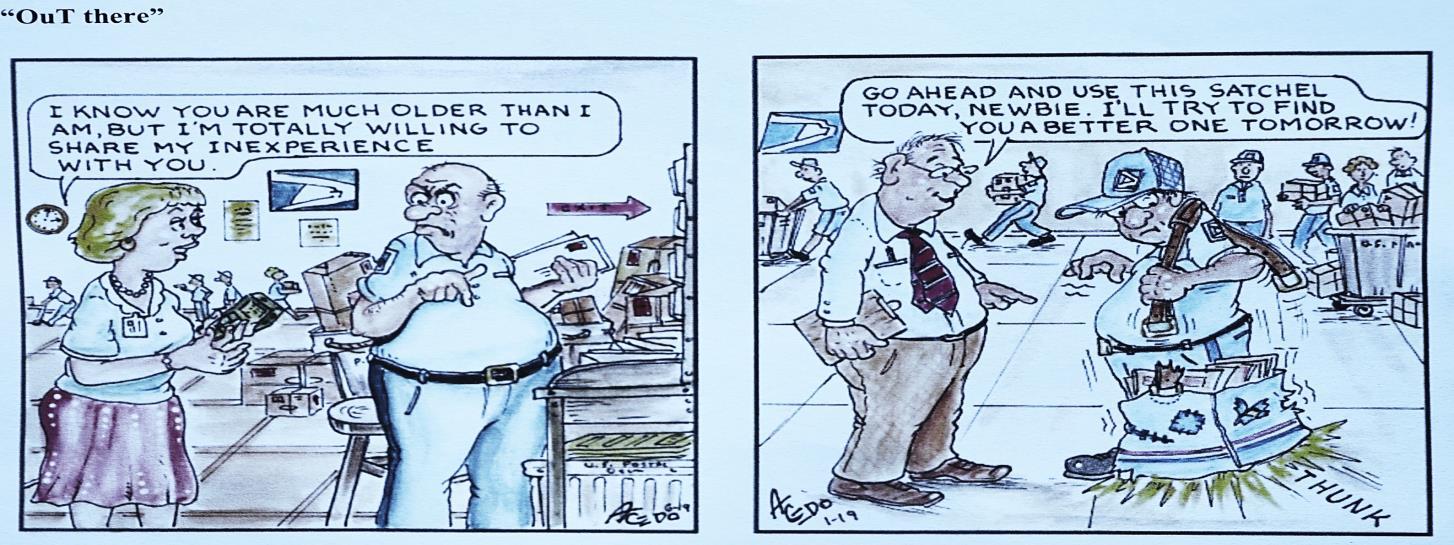
50 Years Ago and Not So Far Away….
By Julie McCormick, Third Vice President
First off, I would like to say Happy New Year to all of you and I hope 2020 brings you and your family health and happiness!
2020 is gearing up to be an eventful year. Hopefully we will see a speedy resolution to the current contract negotiations. The forthcoming conventions at both the state and national level take place later this year as well. I have decided to write a three-part series regarding the Great Postal Strike of 1970, which this March 17 th , will be the 50 th anniversary. To those of you who participated in this strike, I want to thank you for your perseverance and for altering the course of letter carriers for the greater good. If it wasn’t for you taking a stand, I cannot fathom what it would be like for letter carriers today.

Local Bay Area newspapers, March, 1970
So, I want you all to hop in a time machine with me and let’s explore the annals of history to take a look at what led up to the Great Postal Strike of 1970. In order to understand what led up to the strike, we need to discern the early days of America’s postal system.
A nationwide postal system had existed since 1775, even before the Declaration of Independence. This system was put in place by the second Continental Congress, which appointed Benjamin Franklin as the first Postmaster General.
However, up until 1782, the early Americans grew weary of the dependability of the Post Office. Delivery was unreliable, postage rates were out of control, and theft of mail was rampant. Five years later, when the United States Constitution was ratified in 1787, it granted Congress the power to “establish post offices and post roads” and this authority. was finally exercised in 1792 when the United States Congress approved postal legislation. A couple years later in 1794, Congress established the Post Office as a permanent part of the federal government and appointed our nation’s first letter carriers.
When the first letter carriers were appointed in 1794 by Congress, they did not have salaries, rather they were “permitted” by Congress to collect a fee of two cents for every letter they delivered. But these fees did not guarantee a carrier a living wage. During this time period, only the wealthy could afford delivery to their homes. Whereas, everyone else opted to pick up their mail at local post offices, where they were not obligated to pay this “fee”. These early letter carriers’ wages were unpredictable, and they often found themselves working multiple odd jobs to make ends meet.
During these early days, letter carriers were not hired through a traditional hiring process as we have today. They were appointed, so there was very little job security. With the election of Andrew Jackson as president in 1830, many letter carriers lost their jobs. Supporters of President Jackson were hired. to fill these open carrier positions. He would reward faithful members of his party, appointing them to government positions including Postmaster General, local postmasters, and even letter carriers.
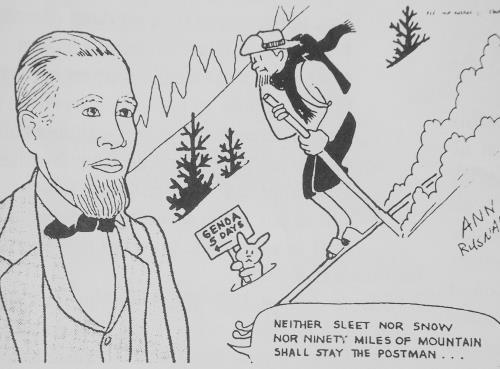
Snowshoe Thompson died May 15, 1876 while waiting for Congress to authorize payment for $6,000 for his 20 years of service between Placerville, Ca. and Genoa, Nv., during the winter snows
There was no job security during this time. During this time, there was a high attrition rate of postal employees with every change in political leadership. It didn’t matter how hard letter carriers worked or their livelihoods, a change in administration often put carriers out on the street. This system made many carriers passive, knowing they would only be hired if they swore allegiance to one political party or another. They would accept atrocious wages and awful working conditions just to stay employed.

Nineteenth century Letter Carriers prior to the founding of the NALC
With these challenges facing letter carrier, local associations of letter carriers started to show up across the country in places like New York and Chicago. These early associations were initially started as mutual benefit associations and social clubs, but they quickly turned into advocacy for better wages, hours and working conditions.
They did this by meeting with local politicians and asking for their assistance. For issues which could not be resolved at the local level, these associations often sent delegates to Washington DC to lobby their senators and other Congressional representatives. However, despite the early letter carriers’ efforts to overcome this spoils system so deeply ingrained into the Postal Service, there was no significant movement to reform this system until after the Civil War.
With the assassination of President Andrew Garfield in 1881, congress finally enacted the first civil service law in 1883, known as the Pendleton Act, which required letter carriers to take examinations to qualify for employment and it included language that made letter carrier jobs permanent. Nearly sixty years after President Andrew Jackson was elected, letter carriers were finally hired because they were qualified for the job.
But another not so subtle effect of the enactment of the Pendleton Act was that Congress no longer cared for letter carriers’ welfare. Since letter carriers were no longer hired due to supporting the political goals of their representatives, Congress had no desire to protect their interests. The implementation of the Pendleton Act helped shift letter carriers interests from pledging their fealty to their Postmaster and Congressional representatives, to each other and the common interests they wanted to fight for.
Between 1881 and 1889, carriers across the country fought for various rights. In 1883, in New York letter carriers and Washington D.C. carriers got together to implement an annual vacation law. Other employees of the Post Office Department were allowed thirty days vacation per year: however, this luxury was not afforded to carriers. After much back and forth, carriers were finally granted fifteen days of annual leave every year.
In 1888 Letter Carriers, along with their congressional ally Joseph “Sunset” Cox, were successful in passing an 8- hour of work per day bill, which was a fight that had started after the end of the Civil War. The 8-hour a day bill was a huge turning point for letter carriers. They started to see their power in organizing for a common cause and achieve results, and there was no better time than to organize a labor union.
In 1889, the Milwaukee Letter Carriers Association issued an invitation to carriers at every Post Office in the United States and on August 29, 1889 the National Association of Letter Carriers was born.
In next month’s article, I will go into what happened after the establishment of the NALC and the opposition letter carriers faced from 1889 through 1949.
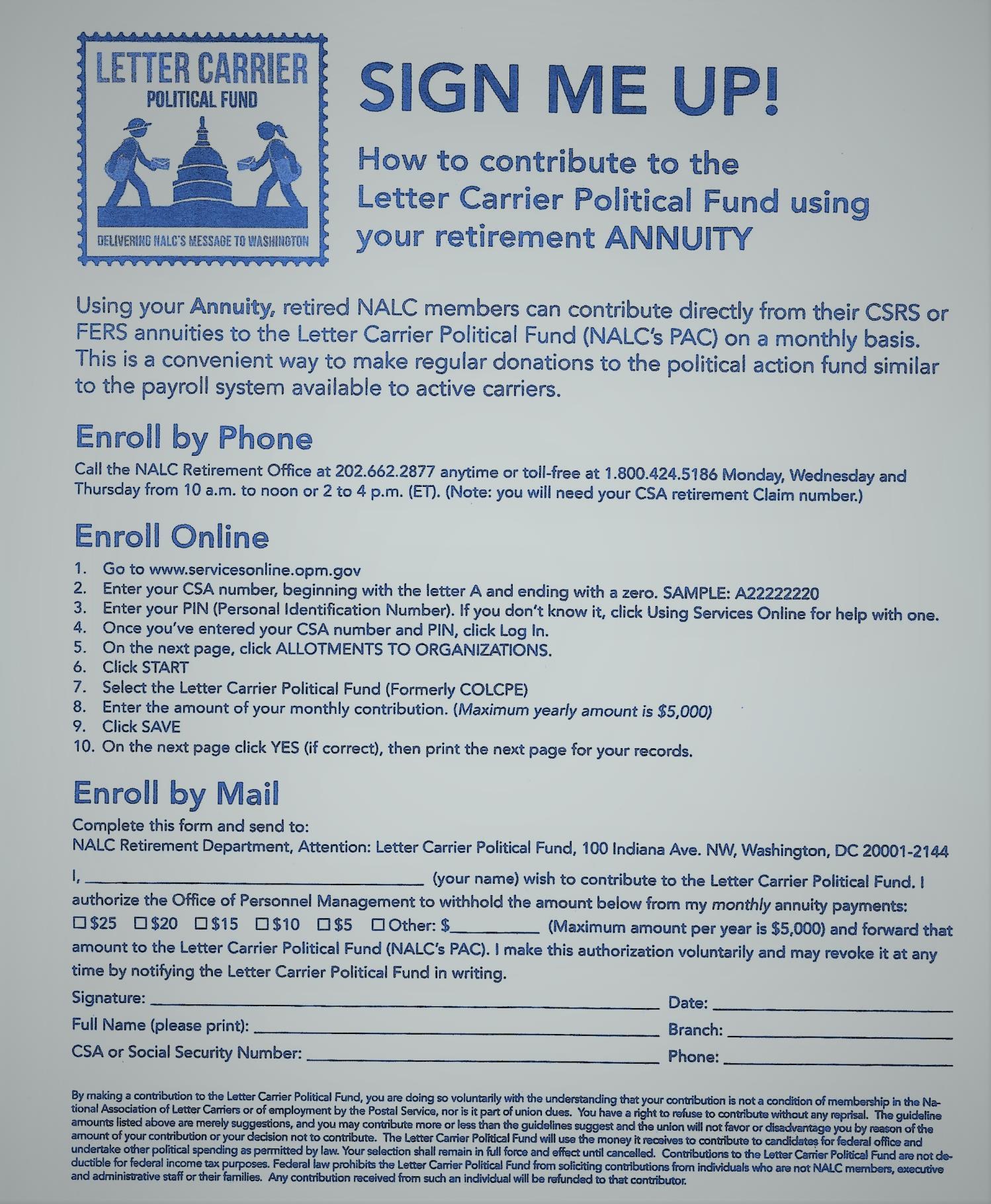
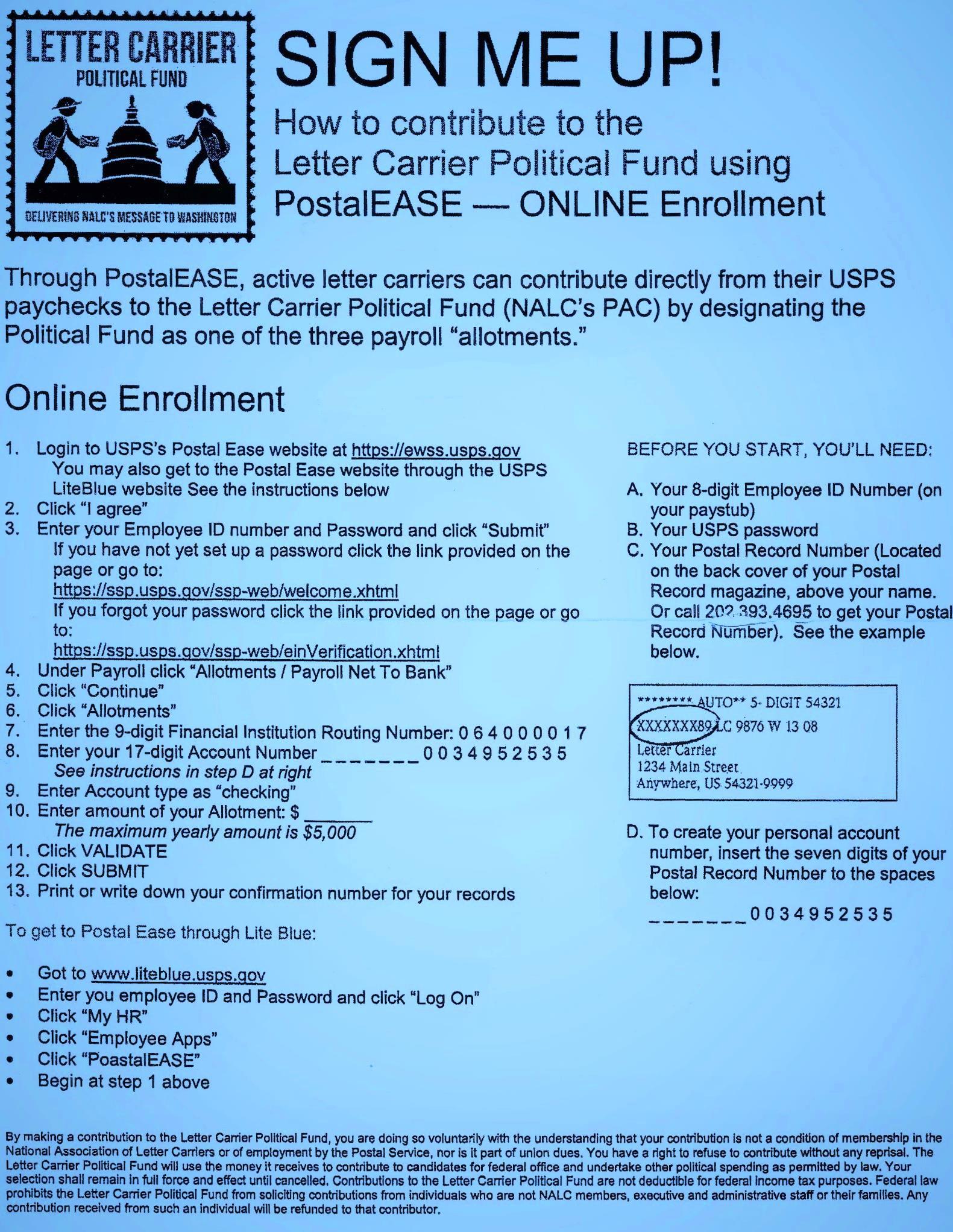

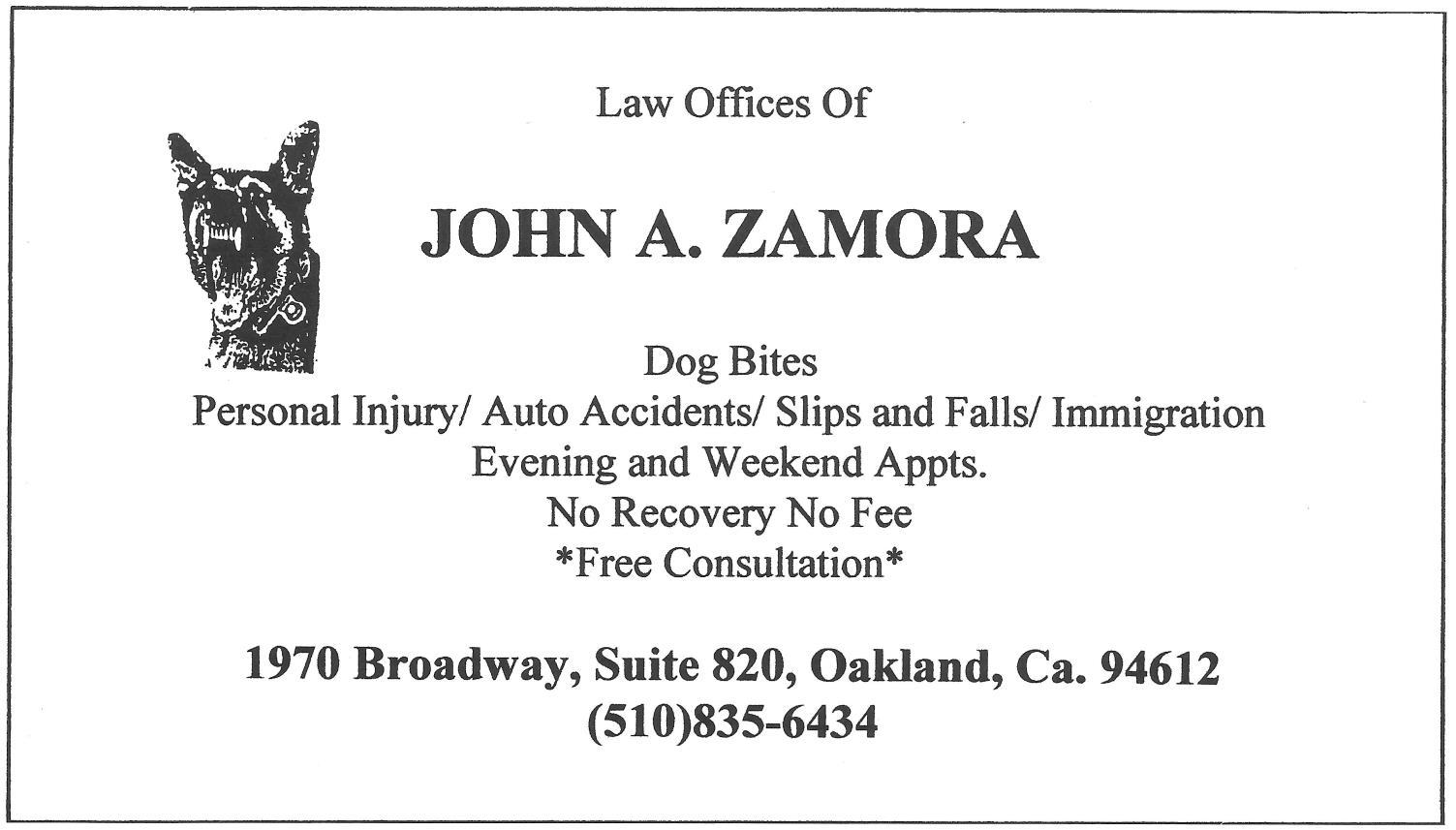
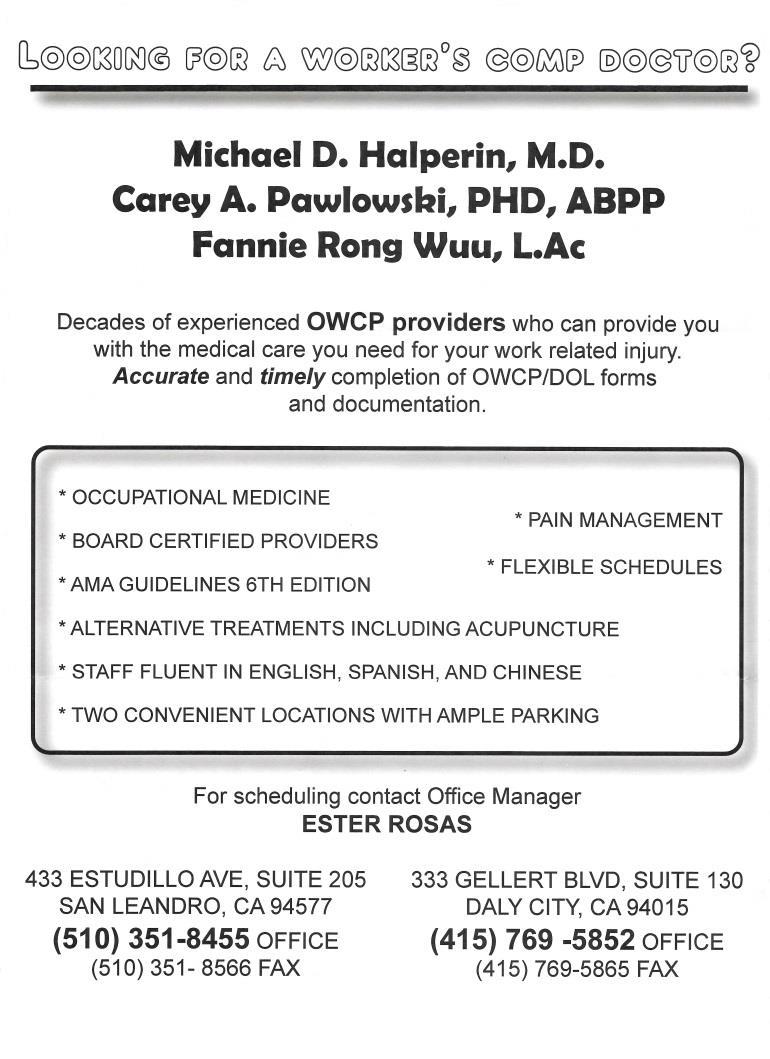

With more than 70 patients from the Letter Carrier Association, Dr. Cabayan has been putting his patients first for over 30 years. Well versed in the rules of the Department of Labor, Dr. Cabayan is able to offer his patients services which include surgeries, braces, medication and medical creams. We hope Cabayan Orthopedics is the practice you will trust to help you heal.

“I highly recommend Dr. Cabayan. He listens to you and will ultimately do whatever it takes to try to heal you. He will actively seek the best option for the patient. I trust him implicitly and have advised my family to see his medical practice.” -Tony Crancer “Dr. Cabayan treats patients in a warm, sincere manner, and he always makes sure you know why a treatment needs to be done and what options you have. I have sent many people to him, and I highly recommend him.” -Marie Rayner
Please visit our website for more patient testimonials. CABAYANORTHOPEDICS.COM (510) 724-4586
Richmond Office: 2970 Hilltop Mall Road, Suite 200 Richmond, California 94806 Pittsburg Office: 2260 Gladstone Drive, Suite 7 Pittsburg, California 94565
Branch 1111 News January 2020 NALC Branch 1111 Balance Sheet As of December 31, 2019 LIABILITIES & EQUITY Total Liabilities 17,389.84 Net Revenue -45,607.90 3900 Unrestricted Net Assets 944,258.86 Equity $896,650.96
ASSETS
Current Assets
Bank Accounts 100 - Petty Cash 128.30 126 PPCU-50 87,555.99 Mechanics Bank Accounts 98,939.06 PPCU-Acct 70 25,603.57 United Bank Accounts 224,432.08 Total Bank Accounts $436,659.00
Other Current Assets
Total Current Other Assets $892,233.80 Total Current Assets $1,328,892.80 Fixed Assets 189 - Accumulated Depreciation -112,256.57 190 - Accum Deprec - Furn./Eq. -68,743.00 191 - Accum Deprec - Computer Eq. -11,561.00 192 - Accum Deprec - Copier -6,896.60 193 - Accum Deprec - Building/Improv-153,573.66 197 - Accum Deprec - Storage Shed -430.00 198 - Accum Deprec –Prior -61,391.17 Total Fixed Assets $- 414,852.00 TOTAL ASSETS $914,040.80 TOTAL LIABILITIES AND EQUITY $914,040.80
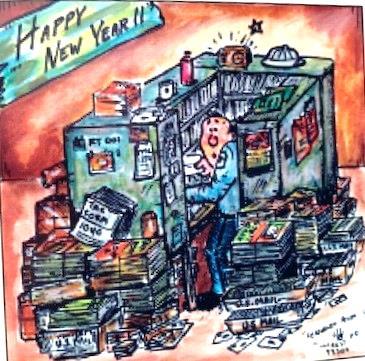
NATIONAL ASSOCIATION OF LETTER CARRIERS GREATER EAST BAY BRANCH 1111 402 –37 TH STREET RICHMOND, CALIFORNIA 94805- 2134 (510) 237-5111
WELCOME NEW MEMBERS Tony Wong Alameda Luis Robles Alameda Raquel Pate Antioch Krystal Arellano Antioch Morgan Carter Antioch Patrick Guidry Antioch Zhane Williams Antioch Daisyann Larkins Berkeley Bob Smith Berkeley Anecia Arasa Concord Lesley Mauricia El Cerrito Carl Randle Fairfield Andrew Kwong Fremont Mohammad Sahebzadah Fremont Gursharan Sidhu Fremont Kunji Khen Fremont Mikayla Perez Fremont Phann Savann Fremont Drew Bishop-Tsai Lafayette Dina Galgano Lafayette Logan Jamison Moraga Richard Dunham Oakland Lily Glasser Oakland Johnathan Guerrero Oakland Tyshika Horace Oakland Sheena Lee Oakland Kong Nguyen Oakland Erick Terry Oakland Hari Paudel Oakland Dariush Saffarian Orinda Jampi Tashi Pinole Johnny Baca-Smith Pinole Christopher Jiminez Pinole Jessica Victorino Pinole Jea’nae Bonds Pittsburg Oscar Warner Pittsburg Rajdeep Sidhu Pleasanton Yunjiao Wand Pleasanton Paul Molano Pleasanton Kimberly Roye Suisun City Veronica Angel Suisun City Mohonned Justice Suisun City Lacaunia White Suisun City Erik Shek Union City Marissa Mauting Union City Sonia Giri Union City Tania Terrado Vallejo Darius Casey-Woodruff Vallejo Stephen Crittle Vallejo Arturo Torres Vallejo Lorena Hernandez Vallejo Amadeo Salditos Vallejo Komaraphat Nakhapatiyu Walnut Creek Rochelle Grisar Walnut Creek
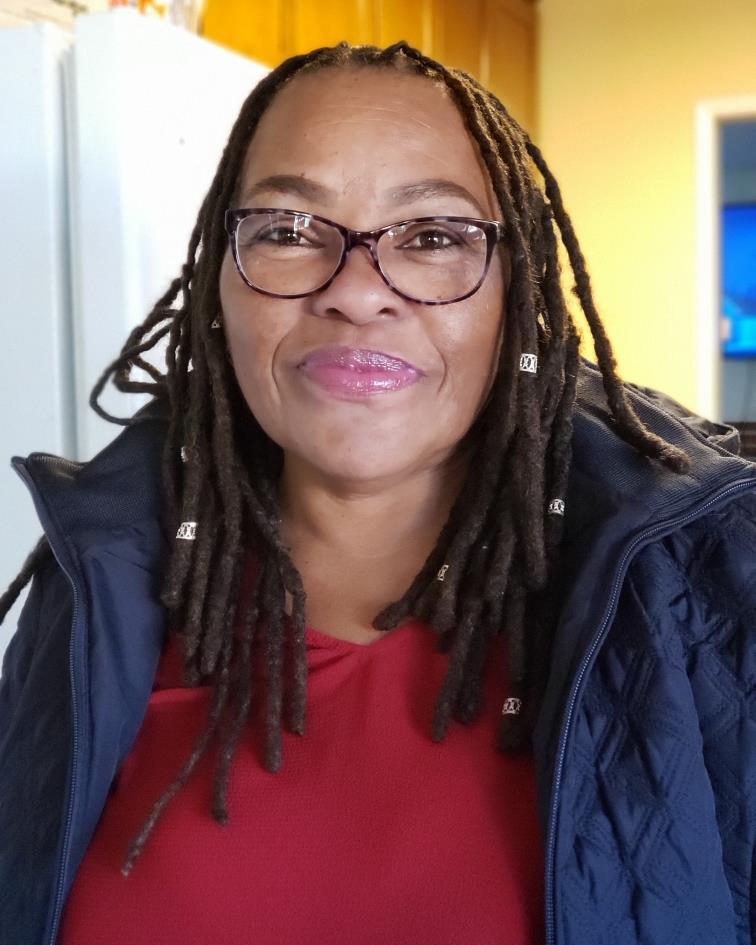
Full time officer and assistant secretary treasure Mary Phelps ready for the New Year!

Greater East BayBranch 1111 News

